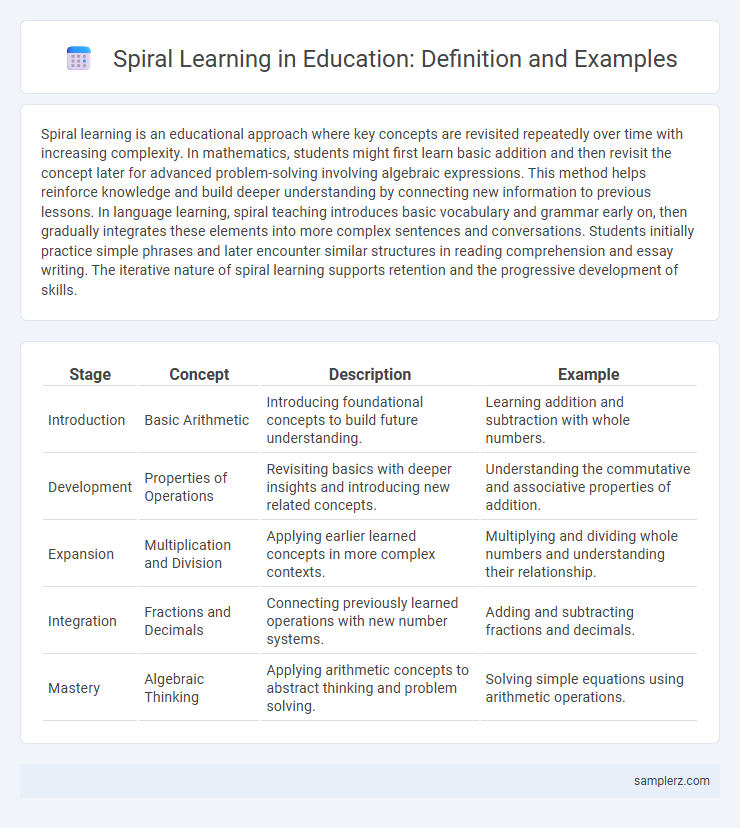Spiral learning is an educational approach where key concepts are revisited repeatedly over time with increasing complexity. In mathematics, students might first learn basic addition and then revisit the concept later for advanced problem-solving involving algebraic expressions. This method helps reinforce knowledge and build deeper understanding by connecting new information to previous lessons. In language learning, spiral teaching introduces basic vocabulary and grammar early on, then gradually integrates these elements into more complex sentences and conversations. Students initially practice simple phrases and later encounter similar structures in reading comprehension and essay writing. The iterative nature of spiral learning supports retention and the progressive development of skills.
Table of Comparison
| Stage | Concept | Description | Example |
|---|---|---|---|
| Introduction | Basic Arithmetic | Introducing foundational concepts to build future understanding. | Learning addition and subtraction with whole numbers. |
| Development | Properties of Operations | Revisiting basics with deeper insights and introducing new related concepts. | Understanding the commutative and associative properties of addition. |
| Expansion | Multiplication and Division | Applying earlier learned concepts in more complex contexts. | Multiplying and dividing whole numbers and understanding their relationship. |
| Integration | Fractions and Decimals | Connecting previously learned operations with new number systems. | Adding and subtracting fractions and decimals. |
| Mastery | Algebraic Thinking | Applying arithmetic concepts to abstract thinking and problem solving. | Solving simple equations using arithmetic operations. |
Understanding the Spiral Approach in Education
The spiral approach in education revisits key concepts at increasing levels of complexity, enhancing long-term retention and deeper understanding. By structuring curriculum to build on prior knowledge through repeated exposure, students develop critical thinking and problem-solving skills over time. This method aligns with cognitive theories that emphasize reinforcement and gradual mastery in effective learning processes.
Key Principles of Spiral Learning
Spiral learning revisits key concepts at increasing levels of complexity to reinforce understanding and retention. It emphasizes the gradual deepening of knowledge through repeated exposure and active application of skills over time. This approach aligns with cognitive development theories, promoting long-term mastery by integrating prior knowledge with new information.
Spiral Curriculum: How It Works
The Spiral Curriculum revisits key concepts repeatedly at increasing levels of complexity to enhance long-term understanding and retention. Each iteration builds on prior knowledge, allowing students to reinforce and deepen their skills through progressive learning cycles. This structured repetition promotes mastery by connecting new material with existing cognitive frameworks, facilitating integrated knowledge development over time.
Real-World Classroom Examples of Spiral Learning
In a real-world classroom, spiral learning can be observed when mathematics teachers revisit fractions across different grade levels, starting with basic concepts in elementary school and progressing to complex operations in middle school. Science educators often use spiral learning by introducing the water cycle in early grades and expanding to detailed environmental impacts in later years. Language arts classes apply spiral learning by revisiting narrative writing skills, gradually increasing the complexity and depth of analysis through successive grades.
Benefits of Using Spiral Methods in Teaching
Spiral learning reinforces knowledge by revisiting concepts at increasing levels of complexity, which enhances long-term retention and deepens understanding. This method promotes cognitive development by allowing students to progressively build on prior knowledge, thereby improving critical thinking skills. Research shows that spiral teaching supports differentiated instruction, catering to diverse learning paces and enabling continuous assessment for tailored educational interventions.
Challenges in Implementing Spiral Learning
Implementing spiral learning presents challenges such as aligning curriculum content with students' developmental stages while ensuring cognitive load remains manageable. Teachers often struggle to design assessments that accurately measure incremental understanding across revisited topics. Furthermore, limited instructional time and lack of professional development on spiral pedagogy hinder effective integration in diverse educational settings.
Spiral Learning Across Different Subjects
Spiral learning revisits core concepts in progressively complex ways across subjects like mathematics, science, and language arts, reinforcing comprehension and retention. For instance, in mathematics, students start with basic arithmetic and repeatedly explore more advanced topics like algebra and calculus, building upon prior knowledge. This approach ensures continuous skill development as learners connect new information to existing frameworks in diverse disciplines.
Designing a Spiral-Based Lesson Plan
Designing a spiral-based lesson plan involves revisiting core concepts at increasing levels of complexity to reinforce understanding and retention. For example, in teaching fractions, students initially explore basic fraction identification, then progressively engage with fraction addition and multiplication in subsequent lessons. This method ensures continuous reinforcement and builds deeper comprehension through cumulative learning cycles.
Research and Evidence Supporting Spiral Learning
Research consistently demonstrates that spiral learning enhances knowledge retention by revisiting key concepts at increasing levels of complexity, aligning with cognitive science principles of spaced repetition and progressive integration. Studies in educational psychology highlight that students exposed to spiral curricula exhibit improved critical thinking and long-term mastery compared to linear learning models. Empirical evidence from classroom interventions underscores that spiral learning fosters deeper understanding and adaptability, particularly in subjects such as mathematics and science.
Strategies for Assessing Progress in Spiral Learning
Spiral learning strategies incorporate regular formative assessments that revisit core concepts at increasing levels of complexity, enabling educators to monitor student progress effectively. Techniques such as concept mapping, reflective journals, and tiered quizzes provide continuous insight into learners' understanding and retention. Data from these assessments inform targeted interventions, ensuring mastery before advancing to more challenging material.

example of spiral in learning Infographic
 samplerz.com
samplerz.com